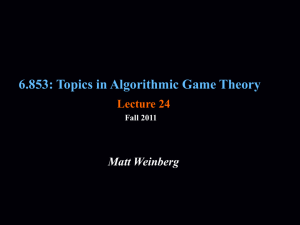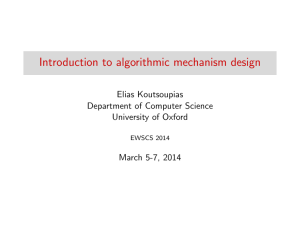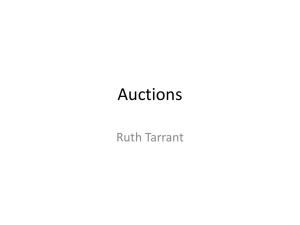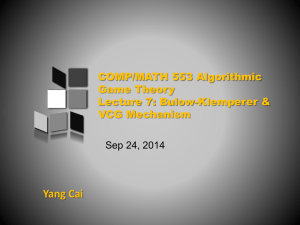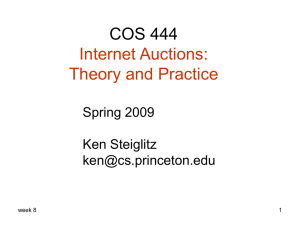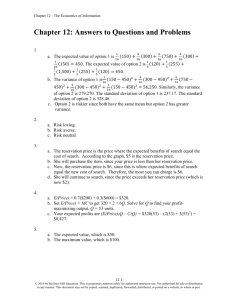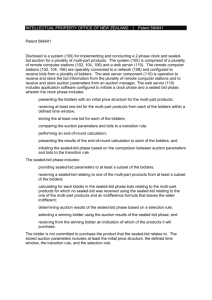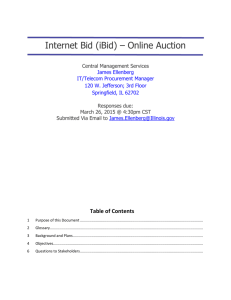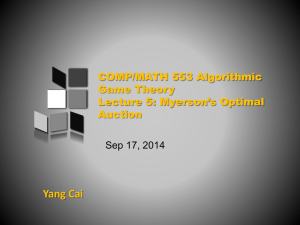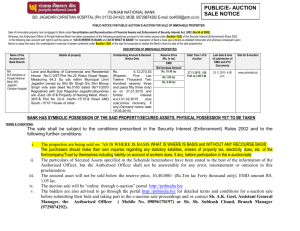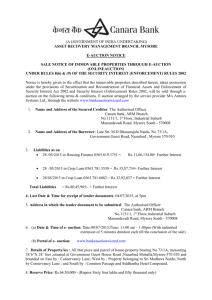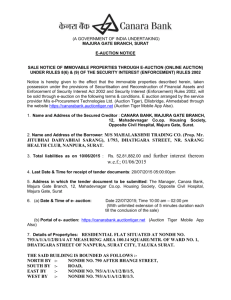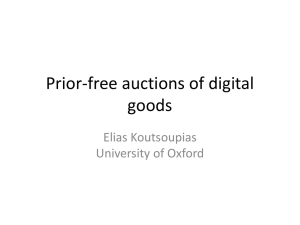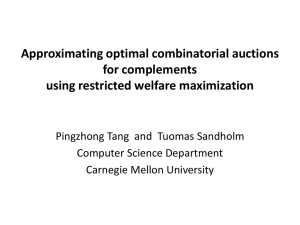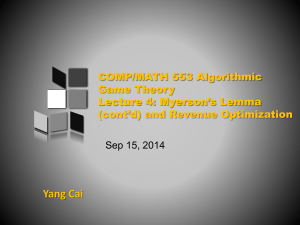Slides
advertisement
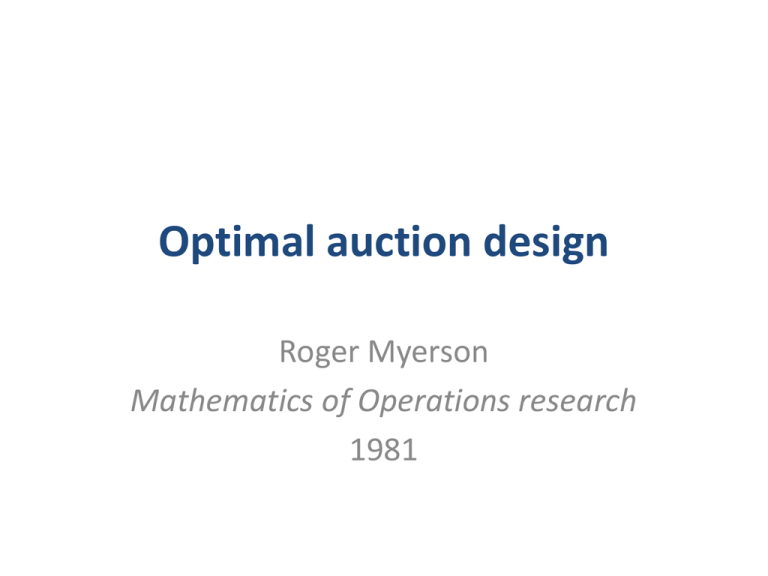
Optimal auction design
Roger Myerson
Mathematics of Operations research
1981
Auctions
• What is an auction?
– Agreement between seller and bidders
• Who gets the item?
• How much does everyone pay?
Optimal auction design problem
• The seller has a single item to sale
• She doesn’t know how bidders value the item
• She wants to make as much money as possible
The setting
• A seller has 1 item for sale, which she
values at 0
• A set of bidders: bidder i’s valuation
(type) ti towards the item is private info
• Others view ti as a random variable in
[ai, bi] drawn from Fi(ti)
• An outcome: a probability pi of
allocation and a payment xi, for each i
– Who gets the item at what price
• Bidder’s utility: ui = pi ti-xi
• Seller’s goal: maximizes her expected
utility/revenue thru a mechanism
• Bidders maximize their expected utility
4
Auction mechanisms
• A mechanism
– Specifies a set Ai of actions for each bidder i
– Outcome function: a1×…an outcome
• A bidder i’s strategy si(): [ai, bi] Ai
• Bidders’ strategies forms a (Bayes) Nash
equilibrium
• Infinite space: action can be anything!
5
Revelation principle
• Direct revelation mechanisms
– Everyone’s action is to report a valuation (Ai=[ai,bi])
– Being truthful is an equilibrium (incentive compatible)
• Revelation principle
– It is WLOG to focus on direct revelation mechanism
– In other words, anything outcome implemented by a
mechanism can also be implemented by a direct
revelation mechanism
Proof
The seller’s problem
• Design direct revelation mechanism (p(t),x(t)),
so as to maximize Et(∑i xi(t)) where (t=(t1,…tn))
• Subject to
– Incentive compatibility (IC)
• truthful is NE
– Individual rationality (IR)
• participation
– Resource feasibility (RF)
• Seller should never
Analysis: constraints simplification
• Interim allocation probability
• Lemma: Constraints simplification
– IC, IR and RF iff
Proof
Analysis:
objective simplification lemma
• Subject to RF and Q being increasing and
Proof
Proof
Optimal auction: the regular case
• Virtual value: ti-(1-Fi(ti))/fi(ti)
• Regularity: ti-(1-Fi(ti))/fi(ti) is increasing in ti
– So that Q is increasing (last constraint satisfied)
• Allocation rule: give the item to the highest nonnegative virtual value
• Payment rule: max {0, Inverse of 2nd highest VV }
Summary
• Upon receiving bids ti from each bidder i
• The seller calculates VV: ti-(1-Fi(ti))/fi(ti)
• The seller gives the item to j who has the
highest non-negative VV
• The seller charges j the amount that would tie
him to the 2nd highest VV
• If all VV are negative, the seller keeps the item
Discussion: bidders may have
different virtual valuation functions
Actual valuation ranking
t1
t2
t3
Virtual valuation ranking
~t1
~t3
~t2
winner is 2
16
Discussion:
symmetric bidders
• Assume Fi=Fj (symmetric bidders)
• Every bidder has the same virtual valuation
function
• Myerson auction is 2nd-price auction with a
reserve price
17
Discussion: Fi=Fj
Actual valuation ranking
treserve
1
t2
t3
Virtual valuation ranking
~t1 0
~t2
~t3
winner is 3
18
Exercise: envelope theorem [Milgron,
<Putting auction theory to work>]
Recent progresses
• Optimal auction
–
–
–
–
Single item setting (Myerson)
Multiple identical item (Maskin&Riley)
Combinatorial items with single parameter (Levin)
Two items with discrete distribution (Armstrong)
• Approximate optimal auction
– 2nd-price auction 2-approximates Myerson (Hartline and Roughgarden,
EC-09)
– VCG 2-approximates Levin (Tang and Sandholm, IJCAI-11)
– One bidder, two item: Separate Myerson 2-approximates optimal
(Hart-Nisan, EC-12)
• Unfortunately: even for 1 bidder, 2 item case, the optimal auction
is unknown!
• Two sellers?





